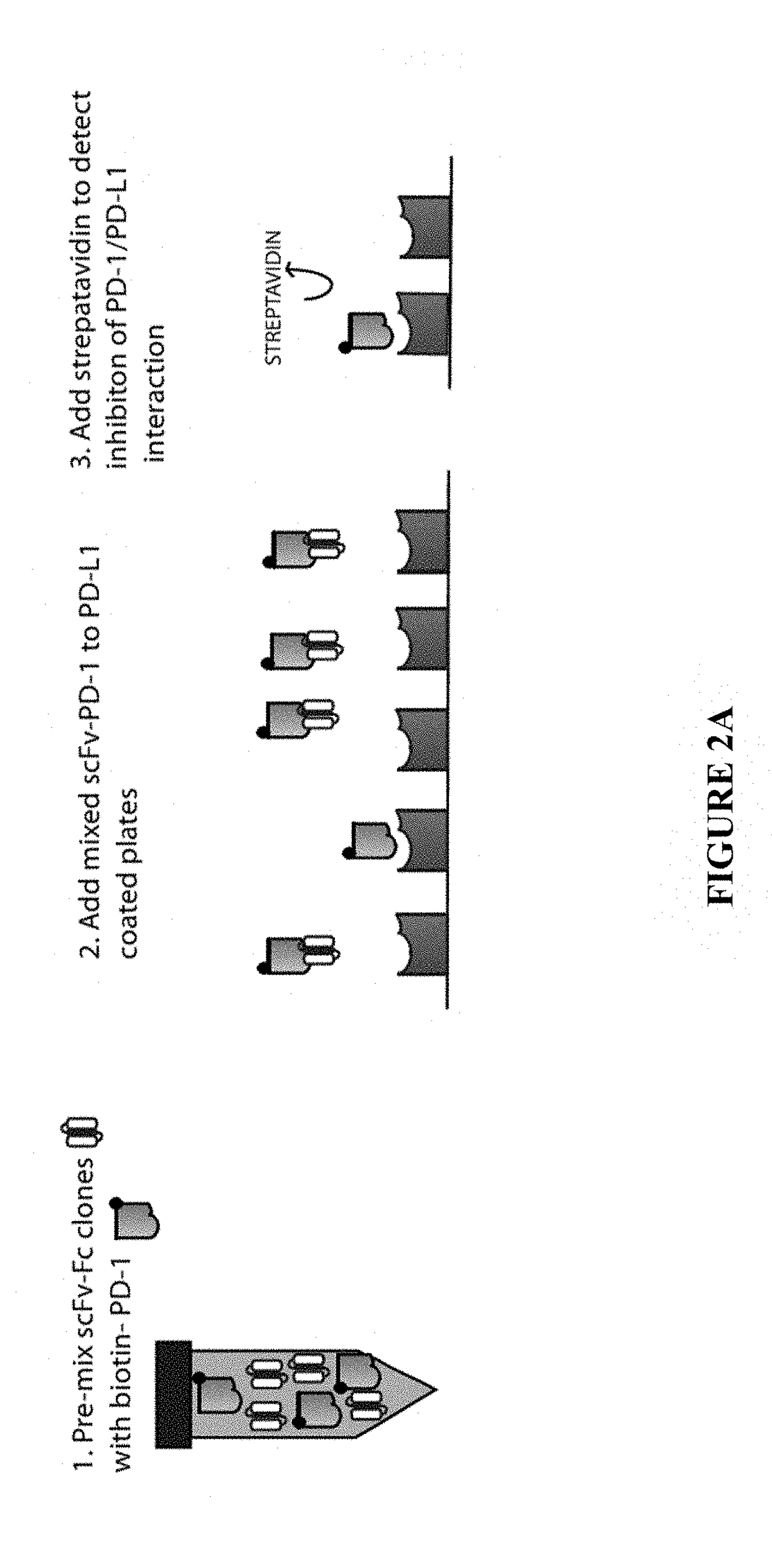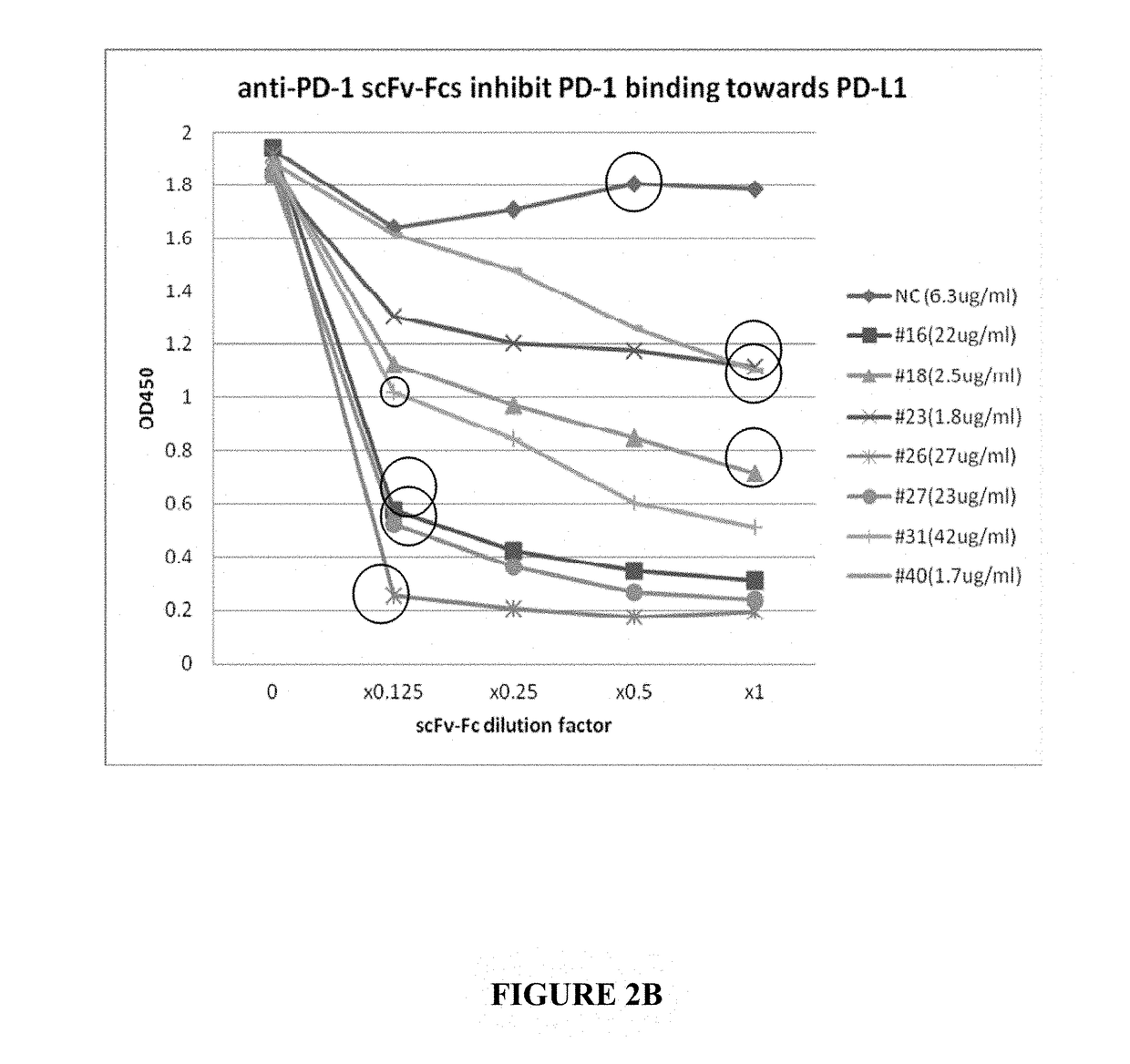Novel pd-1 immune modulating agents
a technology of immune modulation and pd-1, which is applied in the field of recombinant antibodies and chimeric antigen receptors, can solve the problems of poor prognosis of cancer patients across multiple tumor types and the expression of pd-ligands on tumor cells, and achieve the effect of modulating the immune response and inhibiting the apoptosis of t cells
- Summary
- Abstract
- Description
- Claims
- Application Information
AI Technical Summary
Benefits of technology
Problems solved by technology
Method used
Image
Examples
example 1
[0081]To test the ability of the scFvs to inhibit PD-1 ligation, scFv-Fc domain (scFv-Fc) fusion proteins were generated, where the scFvs were linked to a murine Fc (mouse IgG1a) domain. The scFv-Fc clones were then analyzed for the ability to bind PD-1 by coating an ELISA plate with human PD-1 monomer. Binding of the scFvs to PD-1 was quantified using a HRP-conjugated anti-mouse IgG1 Fc secondary antibody. All seven antibodies showed binding activity with respect to the PD1 monomer in a dose dependent manner (FIG. 1). ET901 ScFv-Fc (mouse IgG1 Fc) served as the negative control. Binding affinity of the scFv-Fc clones was ranked where clone 31 bound weakly and clones 26 and 27 bound the most strongly (31<23<40<18<16=27<26).
example 2
[0082]To test the ability of the scFv-Fc to inhibit PD-1 interacting with PD-L1, a competitive ligand-binding assay as shown schematically in FIG. 2A was performed. In this assay, PD-L1-Fc was coated onto ELISA plates. Biotinylated-PD1-Fc was mixed with serially diluted ET901 ScFv-Fc (negative control) or anti-PD1 ScFv-Fcs and then added into the PD-L1-Fc coated plate. PD-1-Fc binding to PD-L1 coated on the plates was visualized via HRP-conjugated streptavidin (FIG. 2B). When comparing similar concentrations of scFv-Fc (circled), the ability to disrupt the PD-1-PDL1 interaction was ranked where clones 40 and 23 had the weakest and clone 26 had the strongest ability to do so (26>27=16>18>31>23=40, FIG. 2B).
example 3
[0083]These clones were then investigated for their ability to regulate specific T cell function. We have previously generated tumor-targeted T cells, wherein T cells are retrovirally transduced to express a tumor-specific chimeric antigen receptor (CAR). We have previously demonstrated that expression of a CAR has redirected T cell function to target a given antigen (Brentjens, Santos et al. 2007). In our lab, we target B cell malignancies using a CAR specific for CD19, termed 1928z (Brentjens, Santos et al. 2007). We have previously demonstrated that CAR modified T cells have demonstrated significant anti-tumor activity in vitro and in vivo and in clinical studies (Brentjens, Latouche et al. 2003; Brentjens, Davila et al. 2013; Davila, Riviere et al. 2014). To determine whether the 7 scFv clones are agonistic (stimulate PD-1), antagonistic (block PD-1) or have no significant effect on PD-1, we generated a secretable scFv by including the murine Kappa leader sequence proximal to th...
PUM
| Property | Measurement | Unit |
|---|---|---|
| concentrations | aaaaa | aaaaa |
| concentrations | aaaaa | aaaaa |
| nucleic acid | aaaaa | aaaaa |
Abstract
Description
Claims
Application Information
 Login to View More
Login to View More - R&D
- Intellectual Property
- Life Sciences
- Materials
- Tech Scout
- Unparalleled Data Quality
- Higher Quality Content
- 60% Fewer Hallucinations
Browse by: Latest US Patents, China's latest patents, Technical Efficacy Thesaurus, Application Domain, Technology Topic, Popular Technical Reports.
© 2025 PatSnap. All rights reserved.Legal|Privacy policy|Modern Slavery Act Transparency Statement|Sitemap|About US| Contact US: help@patsnap.com



